Prolonging the Life of Foods
Whether vegetables, fruit, fish, or meat, the various foods that sustain our lives do not last very long if left unprocessed. With time fresh foods wither or rot, rendering them unsafe for human consumption. Time is foe to perishable foods, for which freshness is all-important.
This is where the art of preservation comes into play. Preserved foods are inventions that have made a friend rather than a foe of time. As well as extending the storage life of foods, preservation can transmute them into entirely distinct foods that are richer in both taste and nutrients. And one way of preserving food is by fermentation, an art that humans-being in perpetual need of food so long as they live-have devised, tested, improved, and handed down through the generations.
Fermented foods are made by harnessing the properties of effective bacteria. Raw fish that is simply left out somewhere will eventually decay. But curing it with salt eliminates miscellaneous bacteria, leaving just the effective microorganisms to do their work of converting proteins to flavorful amino acids. Japanese foods that make use of this process include gyosho (fish sauce), shiokara (salted fish guts), and shuto (a kind of shiokara made with skipjack tuna guts).
The addition of rice in this equation yields nare zushi . Nare zushi is made by pickling fish in salt and rice, which allows natural lactic acid bacteria to produce a tart savor. It largely differs in both form and taste from nigiri zushi, the hand-shaped sushi consisting of vinegared rice with a topping typically of fresh fish that is so familiar today. This only developed in the late Edo period (1603-1868), and the older nare zushi is said to be the prototype of what we now know as sushi.
Origins of Funa Zushi
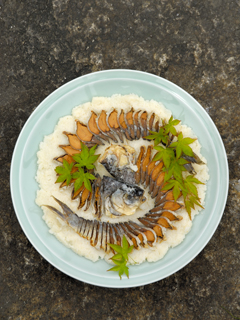
Of the many distinctive nare zushi that are still eaten in various areas of Japan, this article focuses on funa zushi, which is made with fish taken from Lake Biwa. Funa zushi is a traditional specialty of Shiga Prefecture, where the lake is located, and is said to be close to the original sushi. Fresh funa, a fish of the carp family, are caught in Lake Biwa between March and May and cured with salt. Further pickling them in steamed rice promotes fermentation, and lactic acid bacteria and various other microorganisms give the sushi a sour taste. Making funa zushi takes anywhere from a minimum of about a year to a good two or three years of ripening. The meat and bones grow soft as the fish are fermented in rice, and a distinct aroma, savor, and tartness emerge that are at times described as being "like cheese."
In the old days funa zushi was not only for human consumption but was also offered to the gods. As funa were believed to be guardians of paddy fields and rice was a divine bounty, the combination of the two was thought to make an ideal gift to the gods. Accordingly, farmers likely presented the gods with the first funa zushi of the season.
Historical records of the food date back well over a millennium, according to Terutoshi Hibino, a scholar versed in its history. In his article "Omi no funa zushi no rekishi" (The History of the Funa Zushi of Omi), included in the book Funa zushi o kangaeru (Considerations on Funa Zushi ), Hibino writes that the kanji character signifying sushi appears in a document preserved in the Shosoin treasure house, a repository of documents and objects of the Nara period (710-794). He also notes that the writing on a wooden strip unearthed from the Nara-period residence of Prince Nagaya makes reference to funa zushi produced in Chikuzen (present-day Fukuoka Prefecture).
With regard to the funa zushi of Omi (present-day Shiga Prefecture), meanwhile, no records have so far have been discovered as to when it came into existence. But it is frequently mentioned in documents of the Muromachi period (1333-1568) onward as gifts to aristocratic and samurai families. In the Edo period, moreover, domains of the Omi area presented the food to the shogunate as a local specialty, and the funa zushi of Omi enjoyed the privilege of being designated as a favorite of the shogun family.
Through a Tunnel of Crisis
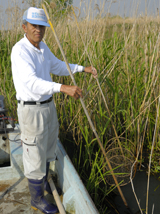
Despite its long history and the centuries of delight that it has brought to locals, the production and consumption of funa zushi in Shiga Prefecture are not exactly booming these days. While reasons abound, one major factor is the dwindling catches of nigoro buna ( Carassius auratus grandoculis ), the particular species of funa that is used to make funa zushi . This decline, in turn, owes in no small part to changes in the habitat provided by Biwa Lake, to which the fish is indigenous. The construction of embankments has led to decreases in reed beds, their spawning ground, while the infestation of black bass and other fish of foreign origin has altered the lake's ecosystem. For many years the nigoro buna have lived under uncomfortable conditions.
The fish's misfortune has also spelled difficulty for producers of funa zushi . Faced with a shortage of nigoro buna, some stopped making the sushi altogether. Others tried using imported fish as substitutes, but this often either altered the product's taste, ultimately estranging customers, or pushed up its price because of higher material costs.
Hopeful signs have recently emerged, however. According to a newspaper article dated April 8, 2008, the Fishery Experiment Station of Shiga Prefecture estimated the number of nigoro buna in Lake Biwa in fiscal 2006 (April 2006 through March 2007) at 6.19 million, the highest since the survey began in 1994. The increase was reportedly due to a combination of factors. The first is that cultured juvenile nigoro buna that are 12 centimeters or longer, and thus too large for black bass and other foreign fish to eat, have come to be released in greater numbers. Second, efforts to raise juveniles in rice paddies and release them into the lake with the paddy water, which is drained in summer, have taken root among local farmers. Finally, this was a bumper year for natural nigoro buna, whose numbers vary from year to year.
Keepers of the Flame
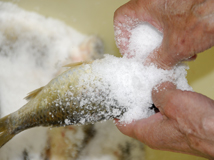
In spite of the difficulties posed by a shrunken population of nigoro buna, there are people who have continued to produce funa zushi through the years. In the following we take a look at three such cases: a private home, a Japanese-style inn, and a specialty maker of the food.
Typically, funa zushi is made by salt curing funa caught in spring and pickling the fish in cooked rice in the height of summer, and after being taken out it is served as part of the New Year's feast. But there are slight-or at times significant-variations between producers in the length of curing, the type and quantity of salt used, the type of rice used, the softness to which it is cooked, and the length of fermentation.
A Private Home: Sadao Araki
In 2008, Sadao Araki of Moriyama-shi fished for funa in mid-March. Early in the morning, he would set bamboo gill nets nearby a reed bed to catch the fish. Reed beds are like nurseries for the fish, which deposit their eggs in the shelter of the reeds. The depletion of reed beds in recent years has made it difficult for young funa to grow.
The scales, gills, and guts are removed while the fish are still fresh. The fish are then cured with salt. Too much salt will keep the bones from softening, and getting the amount just right is a tricky affair. Fluid will come out of the fish as it is cured in large plastic buckets, so stone weights are placed over the lids to keep the fluid from pushing them up. After several months of curing, the fish are taken from the buckets in early August and pickled in cooked rice. Funa zushi are typically pickled for about half a year, but Araki feels that two years are needed for the bones to get tender. Rather than taking them out the following spring, therefore, he waits until winter or spring of the year after.
Nakashige, a Japanese-Style Inn: Shigemi and Katsue Nakagawa
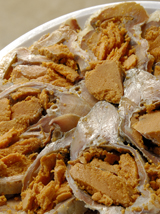
In the northern area of Nagahama, where the lake water is coldest, funa fishing takes place between late April and early May. After setting the nets, Shigemi Nakagawa waits until early next morning to go out by boat and collect the fish. The scales, gills, and guts are removed as soon as the fish are unloaded, and salt is stuffed in through the gill openings. Then, around August or September, the cured fish are pickled in rice.
"The sushi seems to come out delicious when you use enough freshly harvested rice that has been cooked soft to completely cover the fish," notes Katsue.
Once the pickling tubs have been lidded, the couple says, they are like cans that have been sealed. They accordingly take out all of the funa zushi at once, and whatever is not immediately eaten is frozen to keep further fermentation from changing the taste.
"People often say that funa zushi has a pungent smell, but this is partly due to its getting tainted with the smell of the container. That's why we take care to keep the containers clean."
Kitashina, a Specialty Maker: Atsushi and Mariko Kitamura
Atsushi and Mariko Kitamura are the eighteenth-generation owners of Kitashina, which specializes in making funa zushi . The fish that they use have for years been delivered by the same local fishers. During the two-year spell of poor catches in 2002 and 2003, Kitashina agonized over the possibility of not being able to make funa zushi anymore. In 2004 they accepted preorders but did not actually sell the product.
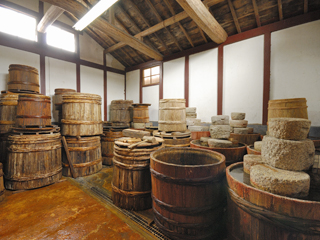
In the back of the Kitashina shop are storerooms where the funa zushi are still made using traditional wooden tubs. The funa are salt cured for about two years, after which they are desalted by rinsing with water and sun drying. The next step is to pickle the fish in rice. Kitashina employs a unique technique called nido zuke, or double pickling, to prevent the distinct odor that is often associated with funa zushi.
"We take pride in the quality of the rice," the Kitamuras say. "For pickling, we use locally grown rice of the Koshihikari variety that has been sun-dried prior to threshing. After putting the fish in the rice we let it sit for a year, and then we pickle the fish again in a fresh bed of rice. So our funa zushi takes more or less three years to finish."
By learning about the nigoro buna of Biwa Lake and the sushi that is made with it, we begin to see a variety of related issues: about local traditional foods, about the preservation of the techniques involved in traditional industries, the economic potential of those industries, about people's palates and tastes, about the continuity of a dietary culture. The funa zushi demonstrates how the fate of a single species of fish can have widespread repercussions on human society.
Fujita, Chieko
Research Adviser
Freelance writer. Drawn by the culture of sake brewing and the people engaged in it, as well as by the taste of sake, has made it her lifework to visit sake breweries across Japan. Organizes the Hakko Link, which is aimed at linking sake with fermented seasonings and fermented foods. Serves on the sake jury under the Nagano Appellation Control system.
Photos: Kazuo Kikuchi
